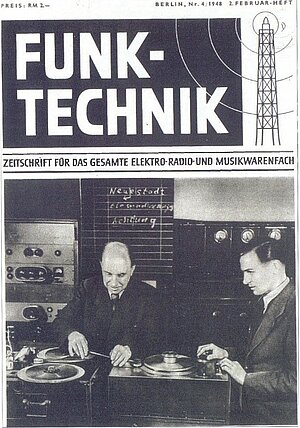January 30, 2018
1948
In the post-war period, female editors corrected errors on magnetic tapes. A new device was developed at the Heinrich-Hertz-Institut as a means to support them and enable an even more precise procedure.
The journal “Funktechnik" (Radio Technology) was published “for the entire electric, radio and music goods industry” in the years 1946 to 1986. In an issue from 1948, an article was dedicated to a new device developed at the Heinrich-Hertz-Institut: a sound detector device for magnetophone tapes, which is intended to considerably facilitate the editing of speech and music recordings. According to the article, the usual cutting method was used to remove errors on magnetic tapes and to connect the recordings with each other in the intended order. This would be done by cutting out faulty recordings and then gluing the tapes together again.
Although experienced editors could easily find the cutting points in the tape recordings, there were also instances, in which the usual approach could prove to produce errors. This would be the case with high-quality speech and music recordings, for example when connecting two music tapes in the required rhythm or when cutting out individual short consonants within a word.
At HHI, executive director Prof. Leithäuser and Dipl.-Ing. Gunka designed a device for these special cases. The device was able to highlight any cutting point on the magnetic tape using a small pen or stencil. It worked as an additional unit next to a normal magnetophone device. The radio technology article concludes by pointing out that the device was not only suitable for editing purposes, but could also be used in language teaching or phonetic examinations.
